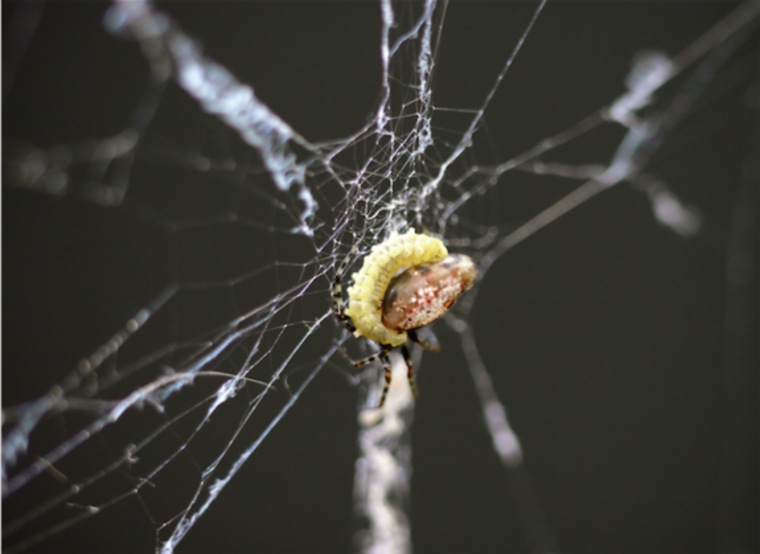Like a mindless zombie controlled by a menacing overlord, the spider scampers back and forth, reinforcing its silky web. Not long from now, the subservient arachnid will be dead, its web transformed into a shelter for the spawn of the creature that once controlled it, according to a new study.
No, this isn't science fiction; it's the somewhat terrifying (but very real) tale of the orb-weaving spider Cyclosa argenteoalba and the parasitic wasp Reclinervellus nielseni, two species that carry out a strange relationship in Hyogo prefecture, Japan.
Together, the wasp and the spider provide a perfect example of host manipulation — an ecological process in which one species (the parasite) and its young (the parasitoids) manipulate the behaviors of another species (the host) to their advantage.

The manipulative relationship between the wasp and the spider begins when a female wasp attacks the orb weaver in its web. She deposits her egg onto the back of the spider's abdomen but doesn't kill it. Firmly attached to the spider, the egg develops into a larva, which eventually does kill its host, but not before the spider serves it as a slave throughout the early stages of development, said Keizo Takasuka, a postdoctoral fellow at Kobe University's Graduate School of Agricultural Science in Japan.
In the lab, Takasuka and his colleagues observed the behaviors of the parasitized spiders — mainly the precise way in which the arachnids built their webs — and then compared this behavior with that of orb-weaving spiders that weren't controlled by parasitoids.
The researchers' study was published earlier this week in The Journal of Experimental Biology.
The zombie slave spiders tended to build a particular kind of web, one that was quite different from the webs created by parasitoid-free spiders, the researchers found. Known as a "resting" web, the pre-molting web is distinct from the spiral-shaped web the spider usually weaves to catch prey. When molting, the spider is soft-bodied, vulnerable and unable to eat. So it stays huddled in the center of the resting web, which has no "capture" areas to snag prey but is instead outfitted with fibrous thread decorations (FTDs), which are strands of silk meant to make the web stand out so animals like birds won't crash into it.
The resting web, a safe haven during times of transformation, is the perfect place for a wasp larva to transition into the pupal phase. An orb weaver's resting web can keep its occupant safe for about two days, which is how long it typically takes the spider to molt. But a web that lasts only two days isn't going to cut it for R. nielseni, which needs to remain ensconced in the spider's web for at least 10 days once it has wrapped itself up in a cocoon.
R. nielseni doesn't just direct its host to build a resting web; it instructs the spider to build a superstrong resting web, one chock-full of reinforced threads that hold the web — and the wasp-filled cocoon at its center — in place for long stretches of time, the researchers found.
With its UV light-reflecting, reinforced shelter in place, the wasp larva no longer needs the spider, so it slaughters it. After chucking the spider's corpse off the web, the larva spins itself a comfy cocoon and hunkers down for nearly two weeks to complete its metamorphosis.
Takasuka suspects that, in the case of R. nielseni and C. argenteoalba, the mechanism controlling the spider's web-strengthening preferences is somehow related to the hormone that is naturally released in the spider, just before molting, that motivates it to start building the nest.
This is a condensed version of an article that appeared on Live Science. Read the original story here. Follow Elizabeth Palermo @techEpalermo. Follow Live Science @livescience, Facebook & Google+.
MORE FROM LIVE SCIENCE
- Mind Control: Gallery of Zombie Ants
- The 10 Most Diabolical and Disgusting Parasites
- Ewwww! Photos of Bat-Eating Spiders
Copyright 2015 LiveScience, a Purch company. All rights reserved. This material may not be published, broadcast, rewritten or redistributed.